Disclaimer: This post contains affiliate links to handpicked partners, including tours, gear and booking sites. If you click through or buy something via one of them, I may receive a small commission. This is at no extra cost to you and allows this site to keep running.
From the City of Nazi Party Rally Grounds to the City of Peace and Human Rights, what sites can we visit to learn about the history of Nuremberg?
Travel is far more than seeking out pockets of beauty, and more about the profound lessons we can derive from people and places, like a trip to Nuremberg in southern Germany proves.
Nuremberg’s history of influence and command is complex and contradictory. Wrapped in symbols of power from the days of the Holy Roman Empire of the German Nation, a trading route legacy and the German Renaissance art period, its dark Third Reich history also shrouds it as the “City of Nazi Party Rallies”.
My history teacher once asked, “What is history?”. It was too simple to define it as just everything in the past. A broad spectrum of events involving people, power and politics, we spoke about the meaning of historical incidents as listings of change – shifts in circumstance, geopolitics, society and culture, or momentous or monstrous occasions.
I first went to Nuremberg 20 years ago on a school trip with that same history class to begin to unravel a horrific historical period and what it meant. Nuremberg Tourism invited me back to see for myself how it was presenting that to the world.

A Nuremberg history lesson – 20 years on
A city answering to its past, Nuremberg doesn’t hide from its history dominated by the actions and rhetoric of the National Socialist (Nazi) Party. In one part, via tourism, the city takes responsibility with its ‘Obligation to the Past’ as an educational platform for the future, which has made Nuremberg today into its self-proclaimed “City of Peace and Human Rights.”
Today, in looking back on change, history is about learning from the past, inviting discussion and evoking understanding. It is something Nuremberg city prides itself on as a centre of some of modern history’s darkest chapters – ones that should never be forgotten and never repeated.
Contents
The History of Nuremberg
From the Middle Ages to the City of the Nazi Party Rallies
Wander Nuremberg, and you’ll soon get lost within its cobblestoned streets of Old Town thatched wooden houses with colourful facades, rebuilt with a focus on restoring the old-style after 90% of the city was destroyed during WWII. Its role as a Nazi stronghold contributed to this.

The colourful streets of Nuremberg Old Town
You can visit the Imperial Kaiserburg Castle grounds that tower over the city, a symbol of golden age power that lasted from 962 in the Middle Ages to 1806 with the advent of the Napoleonic Wars. Nuremberg later became the seat of the Holy Roman Empire of Germanic nations.

Part of the Nuremberg Castle complex – a symbol from being the seat of the Holy Roman Empire of Germanic Nations
Nuremberg’s prosperity was also by virtue to its merchant guilds as part of an extensive trading route in Europe. Alongside that, it became a flourishing centre for the arts – most notably known as the home of the famous German painter, Albrecht Dürer whose house you can visit. As World War II commenced, the construction of a secret art depot in the vaults underneath Castle Hill set to protect this heritage. The storage rooms, accessible now via the Historical Art Bunker tour, were burrowed up to 24 metres below ground, helping the artworks survive the bombing raids on Nuremberg.

Taking a tour of the Historic Art Bunker in Nuremberg

Remnants of bombshells in one of the long passageways if the WWII art bunker
Immediately you realise how WWII wraps itself around the golden time of the Middle Ages and how its symbolism of power, wealth and connection was a reason the Nazi’s chose Nuremberg to be the site of the Nazi Party Rallies.
Sites to Visit in Nuremberg to Understand its History
Nuremberg Nazi Party Rally Ground Sites
On the outskirts of Nuremberg city, the National Socialist German Workers Party (NSDAP) held their annual propaganda Party Rallies between 1933 and 1938.
Having fought against the Weimar Republic and the Peace Treaty of 1919, Adolf Hitler was appointed German Chancellor in 1933. With radical anti-Semitic discourse and brute force, he consolidated his power in 1934 as Führer and Chancellor of the Reich.
The Nazi Party Rally Ground Sites, designed by Albert Speer, were the staging grounds for wielding power, spreading propaganda and getting the public to yield to the party line.

A black and white photograph of a Nazi Party Rally on display at the Nuremberg Documentation Centre Exhibition gives context to the scale of the mass manipulation and display of power
The plan was to have a collection of 12 structures and vast open areas covering 11 square kilometres, to include a Stadium and a March Field, able to accommodate hundreds of thousands of people. The war began and thwarted plans, leaving the completed smaller Zeppelin Field and unfinished Congress Hall.

Our guide holds the Congress Hall design plans; in the background, the unfinished structure
Large parts of these architectural complexes remain, and more recently, the decision about whether these Nazi Rally Ground sites should be kept or demolished was a divisive issue. They are the most sizable remaining constructions from the National Socialist state and party, covering around 4 square kilometres of ground.
The decision was to repair the standing buildings and make them structurally secure. To keep them standing as a lesson about the past and as a warning from history.
All the remaining structures are reminders of how imposing scales of architecture was used for displays of power and propaganda – stripping the sense of individuality, manipulating the masses and enforcing the impression of conformity through fear.

Visiting the former Zazi Rally Grounds sites with a tour is an invaluable lesson on the history of Nuremberg
Freely accessible to all visitors, there are information boards in German and English for self-guidance and historical context. However, we choose to visit with our guide Anne from Geschichte Für Alle (History for Everyone) – the very same people who guided my school history class 20 years ago – for contextual insights as we discussed the history.

Information boards located at one of the former Nazi Party Rally Ground sites in Nuremberg for self-guiding and historical context
Geschichte Für Alle offers a new educational programme with a video-supported bus tour of the Nazi Party Rally Grounds and the Palace of Justice for Courtroom 600. Historical footage of the original locations is shown as an accompaniment to the sites visited. Tour days are Saturday and Sunday, starting at 14:00 and running for one hour. The price is 9 Euro.
Hall of Honour (Ehrenhalle)
We began our guided tour at this memorial hall, erected by the city during the Weimar Republic (1919-1933) to commemorate the nearly 10,000 Nuremberg soldiers killed during the First World War.
Although the Ehrenhalle officially opened in 1930, the Nazi’s used the unfinished Hall of Honour as the staging for its 1929 Party Rally. In glorifying war and applying the cult of the dead as rhetoric, Hitler commemorated these soldiers as “Martyrs of the NS Movement” to move the party soldiers into sacrificing their lives for the cause.

The Hall of Honour (Ehrenhalle) monument in Nuremberg
The adjacent Luitpoldhain (Luitpold Grove) Park was turned into Luitpold Arena for the party rallies but is now recreational parkland as nature reclaims its original use.

Luitpoldhain (Luitpold Grove Park) in Nuremberg today – one of the first Nazi Rally Ground sites used
Congress Hall (Kongresshalle)
The Congress Hall building was the biggest construction project planned by the Nazi’s, although never completed. Planned by father and son architects, Ludwig and Franz Ruff, this oval-shaped arena was based on Rome’s Colosseum and designed to be twice as big.

The unfinished Nazi Party Rally Ground site of the Congress Hall in Nuremberg
You can feel the use of space for intimidation just by standing in one of the straight-cut presiding doorways of the outer marble-clad pillar gallery.
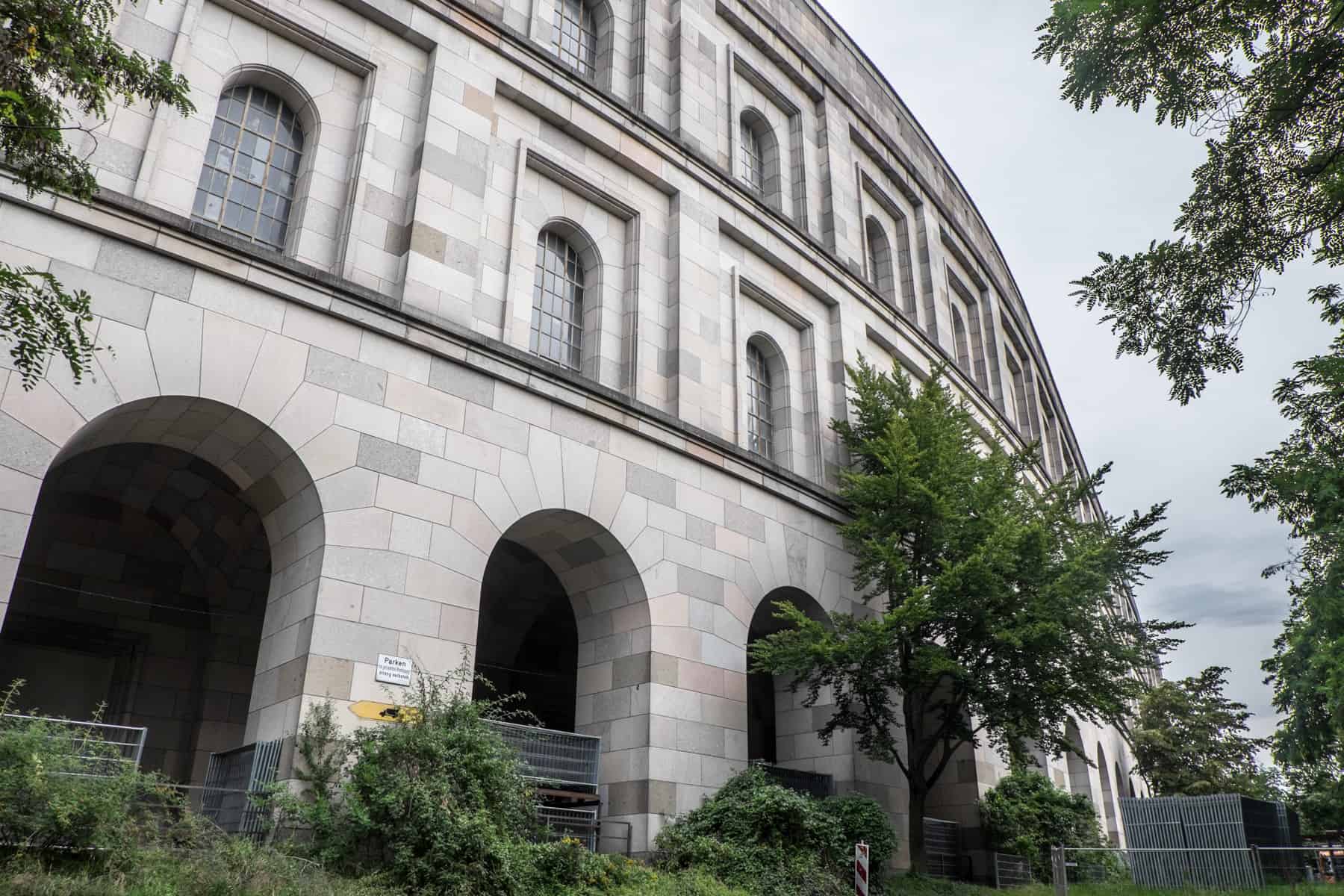
The completed exterior of the Congress Hall (Kongresshalle) – one of the sites of the former Nazi Party Rally Grounds that was meant to resemble the Colosseum in Rome

Architecture as a means of manipulation and fear, as seen at the Congress Hall
The Congress Hall was intended to hold an audience of 50,000 people for NSDAP Party congresses during the Nazi Party Rallies, with a central speakers platform for Hitler and all spectator stands angled to look right upon it.

The interior of the unfinished Congress Hall

Guide Anne from Geschichte Für Alle tours discusses Nuremberg history on a tour of the former Nazi Party Rally Grounds
Zeppelin Field (Zeppelinfeld)
The Zeppelin Field site that held 200,000 spectators has a fortress-like structure with viewing turrets and giant concrete step ledges connected to a grandstand podium, known as the Zeppelin Tribune. It was finished and ready for use in 1937.
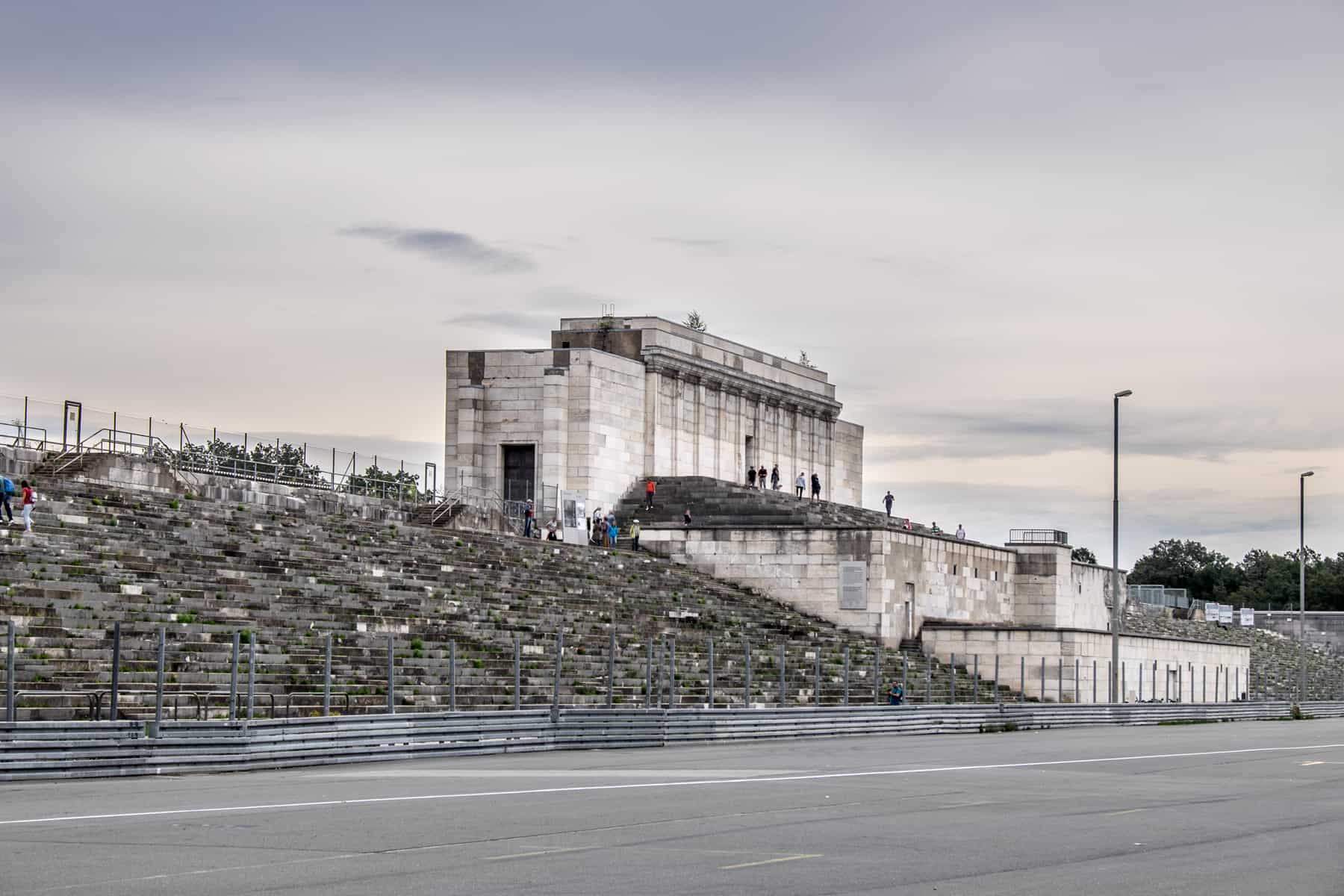
The remains of the Zeppelin Field Nazi Rally Grounds site in Nuremberg
The podium is where Hitler gave speeches during the Nuremberg Rallies, although wooden stands were in place before the 1937 completion. Regardless, it is one part of the site that feels very uncomfortable to stand on.

The remains of the staging steps of the Zeppelin Field

The stone step terrace of the Zeppelin Field site
The Great Road (Große Strasse)
Six thousand granite slabs pave a wide avenue known as The Great Road, designed to connect the enormous rally grounds of the March Field to the Congress Hall. Its use was for the staging of mock battles and military displays of the Wehrmacht (army), alongside Nazi party combat games.

The Great Road – a road for military displays at the Nazi Party Rally Grounds
In the park next to the Great Road in the park is an artificial lake, the flooded hole of which contains the foundation for the German Stadium construction.
The Golden Room
Inside the Zeppelin Tribune is another layer of manipulation through architecture. Large, looming red-tinged marble corridors flanked by enormous steel doors lead to the chilling Golden Room, where a long ceiling of gold stars and swastikas presides over a shaded room. While it is no known for sure what this room’s intended use was, the suggestions are that it could have been an area for party members and VIP guests of the Rallies, or designed for an impressive staging of Hitler’s appearance on the Podium as he gave his speeches.

A frightening display of power inside the Zeppelin Field Nazi Rally Ground site in Nuremberg
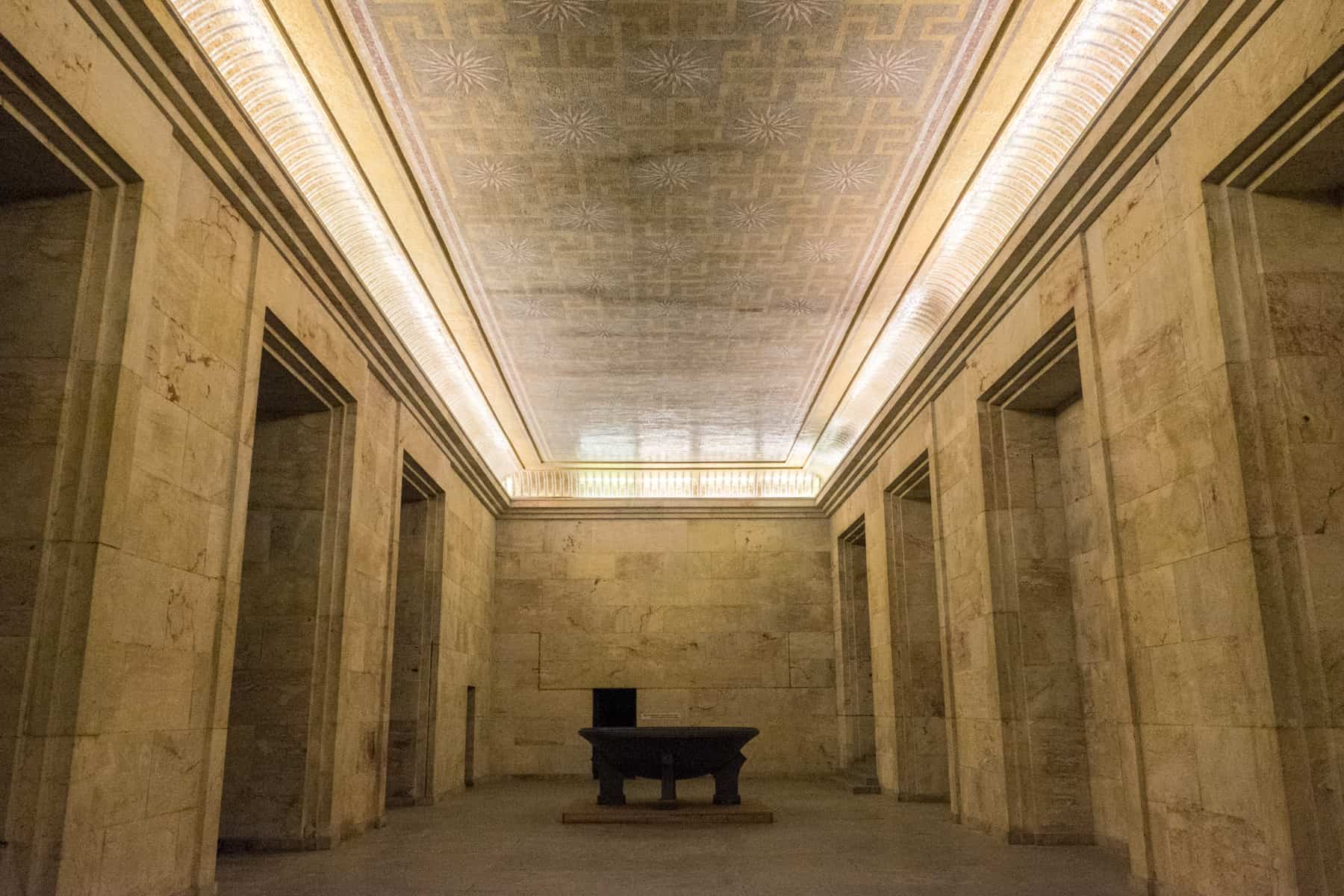
The former Nazi Party Rally Grounds site of the Golden Room

The tall, looming marble-walled corridors Inside the Zeppelin Field Tribune structure
The Golden Room isn’t an open space like the rest of the Rally Ground Sites. Firstly, because it isn’t structurally safe for mass footfall and secondly, if left open, the fear is that it would become a Neo-Nazi shrine. We were able to enter because Geschichte Für Alle has access.
The Nuremberg Documentation Centre
The Documentation Centre sits in part of the unfinished Congress Hall building. A stake-like structure cuts through it creates a meaningful confrontation with the disruption of Nazi architecture.

The Nuremberg Documentation Centre, where a stake-like structure disrupts the Nazi architecture
The audio-guided exhibition, ‘Fascination and Terror’ informs and educate about the causes, context and the repercussions of the National Socialist reign of terror, and shows Nuremberg’s role as the “City of the Nazi Party Rallies” and the power of mass events and propaganda.

Inside the Nuremberg Documentation Centre ‘Fascination and Terror’ exhibition
The exhibition receives over 270,000 worldwide visitors a year, who come to learn about the history of the Nazi era.
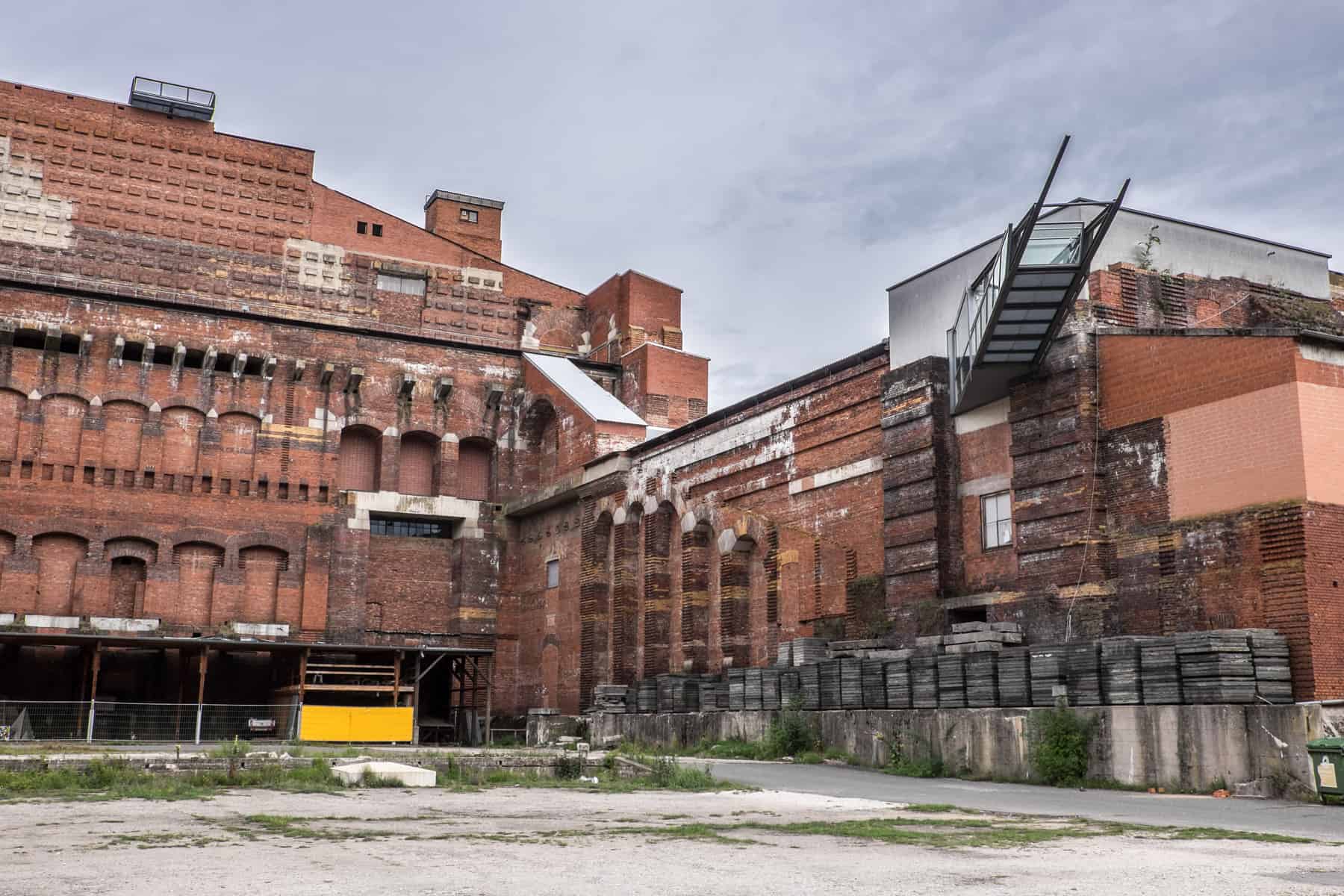
The end of the stake-like structure that hangs outside of the former Nazi Rally Congress Hall building

View of Congress Hall from the viewing platform in the Nuremberg Documentation Centre
The Historical Place of the Nuremberg Trials and Courtroom 600
On 20 November 1945 to October 1st 1946, the trial of the International Military Tribunal by all four allied powers against 24 leading members of the Nazi regime began, of which 21 were present.
Known as the Nuremberg Trials, evidence of the unimaginable suffering, tyranny and terror carried out by the Nazi regime was recounted and assessed in Courtroom 600 at the Nuremberg Palace of Justice and televised as a “world tribunal” to the world stage. It was the first time in history that members of a state had to answer for their war crimes and crimes against humanity before an international court.

Courtroom 600, where the Nuremberg Trials took place
It was a trial that lasted 218 days, resulting in the convictions of 12 times death by hanging, three life sentences and four long-term prison sentences. Twelve additional trials were conducted by the US between 1946 and 1949.
Courtroom 600 marked the start of the significant development of international law, creating the Nuremberg Principles used today in the International Criminal Court in The Hague. Today, it remains a venue for major criminal trials.
Why was Nuremberg chosen as the venue for the trials?
The decision for the first trial to take place in Nuremberg was primarily because of infrastructure reasons. The Palace of Justice had 80 courtrooms, 530 offices and sufficient space for members of staff, the media, alongside the adjacent prison to hold the defendants and incriminated witnesses who would stand trial.
However, with Nuremberg’s association as the “City of Nazi Party Rallies,” this became also a symbolic choice, bringing this period of history to justice.
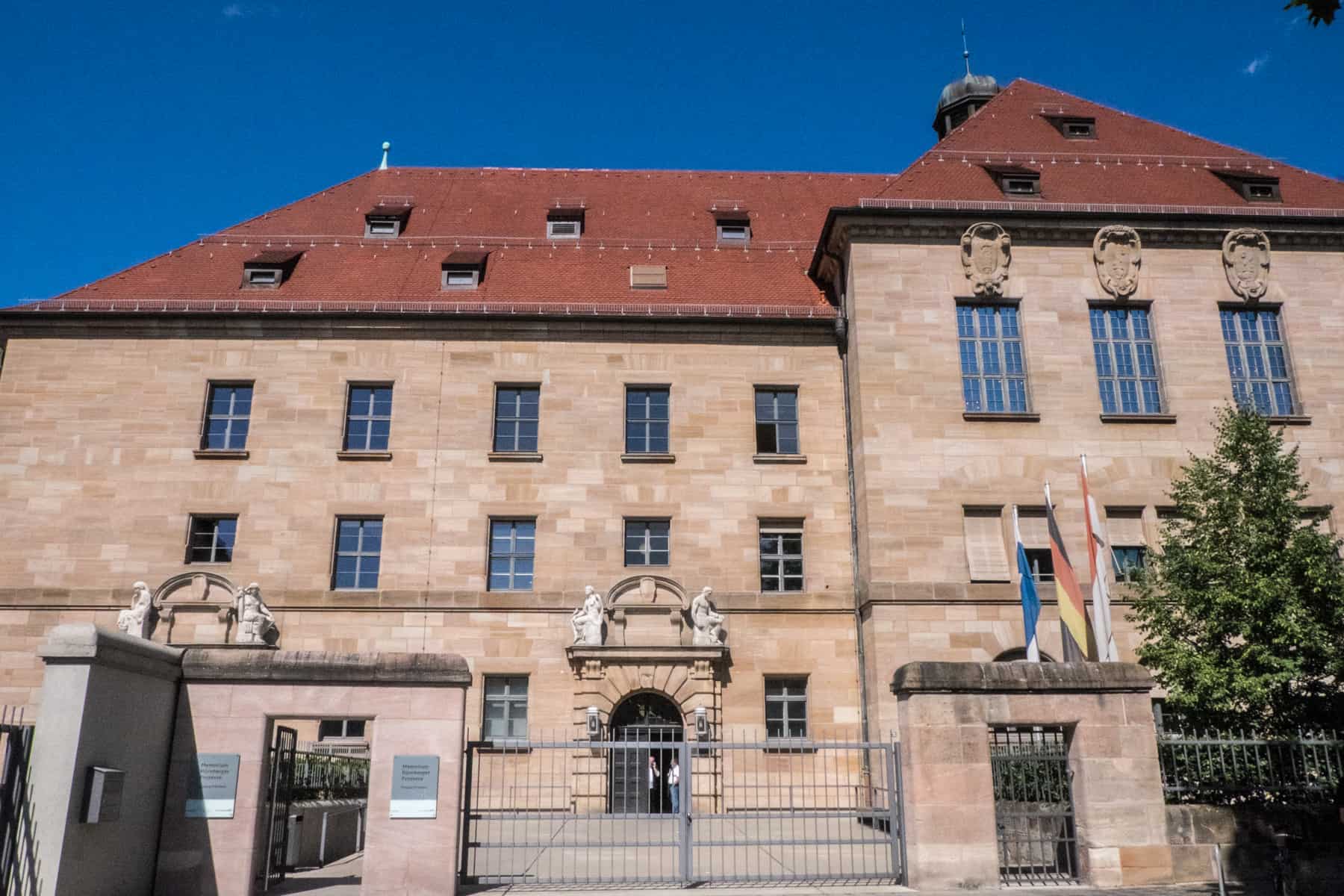
The main entrance to the Nuremberg Palace of Justice
Memorium Nuremberg Trials Exhibition
The extensive and audio-guided Memorium Nuremberg Trails exhibition, on the top floor of the courthouse, opened in 2010, and details the trails in Court Room 600 and their progress, the evidence presented and the historical events and documentation that supports this.

One of the many detailed displays at the Memorium Nuremberg Trials Exhibition
It provides a new layer of education beyond the videos of the televised trials, and it includes exhibitions on the impact of the Nuremberg Trials concerning more recent worldwide crimes and atrocities.

One of the educational displays showing which leading Nazis were on trial at the Memorium Nuremberg Trials Exhibition
The overall aim in their words is for the exhibition to be: “A reminder to visitors of the importance of the trial as a milestone of international criminal justice and as a synonym for the end of impunity for war crimes and crimes against humanity.”
Nuremberg Today – Moving Forward
Repurposing a Dark Past
Nature has mostly reclaimed the space and covered some structures, seating areas or remaining foundations. Today, this vast area is a recreation ground, slowly blending with the nature of the adjacent lake, where it’s not uncommon to see people walking their dogs and running.

Nature reclaims the structures of the former Nazi Rally Grounds in Luitpoldhain Park
While the buildings are prominent reminders of a dark past, they are repurposed and given a new life – one that brings people together in a positive harmony.
The annual Rock im Park rock festival takes place on the grounds of the Zeppelin Field where over 150,000 people come to revel, and the Norisring motor racing weekend circuit inside the former Nazi Party Rally Grounds starts and finishes in front of the grandstand.

Rock im Park in Nürnberg. © Uwe Niklas with permission from Nuremberg Tourism

Norisring racing event in Nürnberg © Uwe Niklas with the authorisation from Nuremberg Tourism
The South Wing of the Congress Hall was renovated into a concert hall in 2008 and is the stage for the Nuremberg Symphony Orchestra. Clarinettist, Giora Feidman, whose specialism is Jewish klezmer music, opened the inauguration concert. Open-air concerts regularly take place in the Congress Hall southern inner courtyard, with other sections utilised for storage space. When I visited in August, there was a fairground site set up outside of it.

A funfair on the site of the former Nazi Party Rally Grounds in Nuremberg

Parts of the Congress Hall repurposed for storage facilities
While it might be surreal to see such events, it is symbolic of defeating the site’s original purpose and not letting such evil prevail.
Nuremberg as the City of Peace and Human Rights
Nuremberg is a city answering to its past for a better future. In doing so, it has proclaimed itself as the “City of Peace and Human Rights.” The artwork that flanks the entrance to the Germanisches Nationalmuseum, created by Israeli artist Dani Karavan, symbolises this.
The Way of Human Rights is an avenue comprised of 27, 9-metre high concrete pillars, each one inscribed with an article of the General Declaration of Human Rights in German and another language. Since the Declaration of Human Rights has 30 Articles in total, there are an additional two slabs on the ground and a tree to complete the symbolism.
To further its commitment, Nuremberg’s Foundation has presented the International Human Rights Award since 1995

The Way of Human Rights artwork in Nuremberg
However dark Nuremberg’s modern history is, and whatever side of the debate you stand on about whether such relics and structures should remain on display, we all can learn something by visiting these sites.
They are an integral part of the learning process and the interpretation that such history never is repeated. And with that, you too become a part of Nuremberg’s Obligation to the Past.
Things to Know About Travel To Nuremberg
Getting to Nuremberg
Nuremberg is well-connected on the European flight network, and Nuremberg Airport is very close to the central city by the metro, which runs every 10 minutes.
It took us 30 minutes to get from the airport station to the central metro station of Opernhaus, although you will reach Central Station within 12 minutes. A perfect walking city of which takes you 20 minutes on foot to cross from one side to the other, all major sites within the city centre are not far from one another.
Where to Stay in Nuremberg
The bulk of Nuremberg’s historical sites are located within and around the Old Town area. The former Nazi Party Rally Grounds on the outskirts of the city are accessible via the tram network.
We stayed in the 3-star Hotel Elch – one of the oldest hotels in Europe dating back to 1342. It’s a perfect hub in the heart of the Old Town, 400 m from the central market square and 600m from Castle hill. The hotel has been refurbished in a boutique-style, yet retains some historical fixtures and style, including some hints of the old thatched wood design. It’s also perfectly placed to enjoy the traditions of the city, including the sausage, red beer and gingerbread of the must-try Nuremberg food list.
The Nuremberg Card
The Nuremberg Card costs €28 and is an all-inclusive card giving you free access to all the city’s museums and attractions, including the underground cellars, art bunker and castle dungeons, and use of all public transport for 48 hours. It is also valid in neighbouring Fürth, with the same benefits.
The requirement is that you stay overnight in Nuremberg or Fürth in an official commercial accommodation. Further details, alongside how and where to collect your card can be found here before your travel in Nuremberg begins.




Leave a Reply